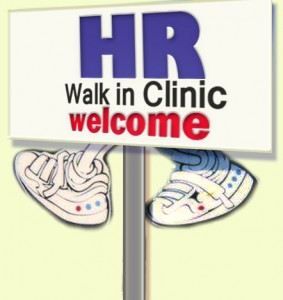 While I agree that HR professionals should not seek center stage or public recognition for their role in an organization’s success, ey should also not be invisible to employees or their employers. They are too valuable to an organization’s success to be completely invisible. They must be approachable and available every day. HR Advocate envisions HR professionals in a service oriented or customer service role, in which we are serving the needs and interests of our customers. So, who are the customers of HR? Libby Sartain, in her book HR from the Heart, breaks down the answer this way:
While I agree that HR professionals should not seek center stage or public recognition for their role in an organization’s success, ey should also not be invisible to employees or their employers. They are too valuable to an organization’s success to be completely invisible. They must be approachable and available every day. HR Advocate envisions HR professionals in a service oriented or customer service role, in which we are serving the needs and interests of our customers. So, who are the customers of HR? Libby Sartain, in her book HR from the Heart, breaks down the answer this way:
- The CEO
- The shareholders
- The customers of the organization
- The employees
In other words, the customers of the entire enterprise. Sartain makes the powerful point that when we as HR professionals regard everyone as a customer of the organization, then our philosophy becomes service-related. And as a result we stand a much better chance of working in sync with the company as a whole and aligning the goals and deliverables of HR with the company’s goals and deliverables.
Convey trust to employees
The most important thing for an HR person to convey to employees and their employers is that they can be trusted. HR professionals are trusted with each employee’s dreams, aspirations, concerns, worries, and fears. We are often entrusted with information that must remain confidential, yet will require action on our part. Action that is both in the best interest of the organization, and hopefully in the best interest of the employee.
Yes, we still have to design and then follow company policies and mete out unpleasant verdicts on discipline or terminations, but we can still be seen as credible, fair and trustworthy. If we act ethically at all times we should not be perceived as a threat. When we can’t deliver what an employee or a manager may want, striking a balance between their needs and what is best for the company is often the best we can do.
In a fairly simply example, you have a valuable and talented employee expecting a big raise after that Master’s degree they earned. Perhaps it’s just not in the budget to pay more for that person’s position that year.
Instead of a flat no, we can be sensitive to that employee’s request, acknowledge the validity of it and try to find a creative way to keep that employee engaged and not rushing off to get on CareerBuilder to look for another job. Especially if, it’s not an employee the company can afford to lose.
Is there another opening in the company that fits better for that individual where the paygrade is higher? Could some crossteam assignments position that employee for a position shift within a few months? Of course, if we have been tuned in to what’s going on with that employee, this request for an increase in salary would not have come as a surprise, and a career development plan would have already been mapped out for this individual that lets them grow, earn more pay, and the company prosper simultaneously.
Human Resources’ human harmony
Most people who seek out a career in HR recognize that the very name of the profession includes the word “human” for a reason. HR professionals want to work closely and in as much harmony as possible with the humans, the people, who make an organization prosper. To do that successfully we have to continuously act as coaches, teachers, listeners, team players, organizers, researchers, and managers, all with the goal of moving the organization and its whole range of “customers” forward. Who needs limelight, when you have such a satisfying and challenging role to play? Franny Oxford is right. Start your own company if you are looking for the Oscar.
No Oscars will be awarded during The HR Power Hour, but HR Advocate can develop a powerful personalized HR action plan to boost your organizational performance and reduce risk with proven methods.
